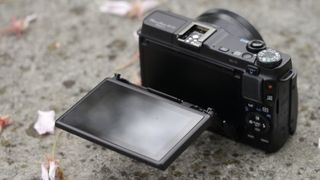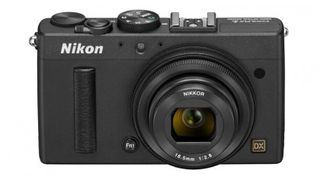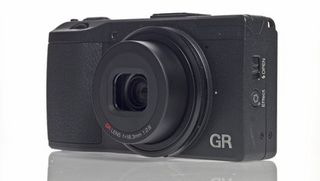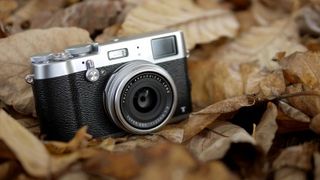Best big sensor compact
Small cameras usually come with small sensors, but these beauties give you the best of both worlds

• Read our full Canon G1 X Mark II review.
For years the G1 X was considered the king of the premium compact, and Canon's G1 X Mark II has addressed some problems with its predecessor to produce a still very capable offering.
You get a large sensor, which is almost as big as APS-C and a flexible 5x optical zoom. Offering f/2.0 at the wide angle and falling to f/3.9 at the telephoto end, it's not quite as bright as the Panasonic's zoom lens, though (f/1.7-2.8).
The Canon features a Digic 6 processor which delivers excellent noise control, and images are characterised by that pleasing Canon warmth the company is known for. It also features a responsive touchscreen and inbuilt Wi-Fi.
The Canon combines super quick processing and fast focusing with great image quality but, unfortunately it's also the heaviest, if not the largest, of these cameras – it's not really pocketable.
Nikon Coolpix A
Sensor size: CMOS, APS-C | Lens: 28mm f/2.8 | Pixel count: 16.2Mp | Screen type: 3-inch, 921,000 dots | Viewfinder: No | Maximum continuous shooting rate: 4fps | Maximum video resolution: 1080p

• See our full Nikon CoolPix A review.
Nikon fans looking for a pocketable alternative to their DSLR should find plenty to like in the Coolpix A, which has an APS-C sized sensor and fixed 28mm f/2.8 lens.
There's also no anti-aliasing filter in front of the sensor, which should mean sharper fine detail, and the images produced by this camera are great – they almost match those of an equivalent DSLR and lens combination, though there is evidence of corner shading in some cases.
Unfortunately, there's no touch sensitive screen, nor inbuilt Wi-Fi, and focusing can be a little slow at times. If you're a Nikon user though, you'll be at home with the menu system.
The CoolPix A's controls are sensibly arranged, so it's easy and quick, but the corner shading issue does suggest Nikon has pushed technology a little too far in cramming an APS-C sized sensor inside such a small body.
Nevertheless, the CoolPix A is an enjoyable camera to use and can produce excellent images, and its small size makes it a good pocketable option.
Ricoh GR
Sensor size: CMOS, APS-C | Lens: 28mm f/2.8 | Pixel count: 16.2Mp | Screen type: 3-inch, 1,230,000 dots | Viewfinder: Optional | Maximum continuous shooting rate: 4fps | Maximum video resolution: 1080p

• See our full Ricoh GR review.
The pocket friendly Ricoh GR is also the most wallet friendly here, having been around for some time now.
Inside you'll find an APS-C sized sensor, and like the Nikon Coolpix A, a fixed length 28mm f/2.8 lens.
It's also missing an anti-aliasing filter to help it deliver excellent detail reproduction, while colours are natural and exposures are good. Noise is well controlled, but it's advisable to shoot in raw format to get the most from the camera.
There are negatives, though. There's no inbuilt Wi-Fi, the screen isn't touch sensitive and you could argue that those cameras with a zoom lens will offer more flexibility – though many people who buy this kind of camera prefer the simplicity and discipline of a fixed focal length lens.
All in all, the Ricoh GR is a perfectly pocketable DSLR alternative, which gives you all the manual control you need. The display can be a little hard to see in very bright light, or from awkward angles, but the great customisation options plus sharp, high quality images still make this a good all-rounder.
Fuji X100T
Sensor size: X-Trans, APS-C | Lens: 35mm f/2 | Pixel count: 16Mp | Screen type: 3-inch, 1,040,000 dots | Viewfinder: Hybrid optical/EVF | Maximum continuous shooting rate: 6fps | Maximum video resolution: 1080p

See our full Fuji X100T review.
Along with its APS-C X Trans CMOS sensor, the X100T features a fixed focal length 35mm equivalent f/2 lens and a range of traditional controls that enthusiasts will appreciate and which help to give the Fuji a gorgeous retro look.
It'a also fitted with an excellent hybrid viewfinder which gives you the choice between optical and electronic viewing – generally speaking we prefer the electronic version, though Fuji has added real-time parallax correction and a magnified window for manual focusing while using the optical 'finder.
A quick and accurate focusing system, along with excellent image quality make this a great choice for many. Wi-Fi is built in and you can control the X100T remotely from your smart device using Fuji's free Camera Remote app.
The robust build and beautiful design make the X100T a thing to behold. As long as you can live with the fixed focal length lens, you'll love this gorgeous, retro-inspired camera and its fantastic controls and manual operation.
Not sure if any of these are the right camera for you? See our exclusive Techradar digital camera guides:
- Best camera: we explain the types, features and things to look for
- Best compact camera: from point-and-shoot compacts to bridge cameras and travel zooms
- Best mirrorless compact system camera: how they work and how they are challenging DSLRs
- Best DSLR: still the cameras of choice for keen amateurs and professionals
Get daily insight, inspiration and deals in your inbox
Get the hottest deals available in your inbox plus news, reviews, opinion, analysis and more from the TechRadar team.
Amy has been writing about cameras, photography and associated tech since 2009. Amy was once part of the photography testing team for Future Publishing working across TechRadar, Digital Camera, PhotoPlus, N Photo and Photography Week. For her photography, she has won awards and has been exhibited. She often partakes in unusual projects - including one intense year where she used a different camera every single day. Amy is currently the Features Editor at Amateur Photographer magazine, and in her increasingly little spare time works across a number of high-profile publications including Wired, Stuff, Digital Camera World, Expert Reviews, and just a little off-tangent, PetsRadar.

